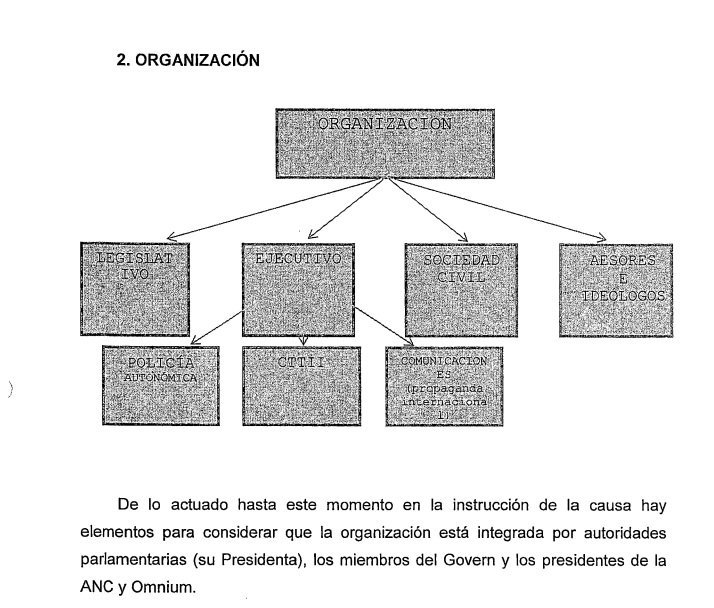Spanish judge Carmen Lamela of the National Audience court has sent a report to the Supreme Court, requested by the second body which is looking to bring together all the cases related to the Catalan independence process. Lamela describes what she sees as a criminal network, an organisation sharing out roles "to carry out a preconceived plan".
In her report, Lamela says that there are reasons to believe that those under investigation formed an organisation that "acted with unity of purpose, in agreement with a common plan and sharing out tasks and responsibilities to achieve the secession of the Autonomous Community of Catalonia and its proclamation as an independent Republic, thus altering the political organisation of the state and its form of government, in clear contravention of constitutional and statutory order".
The judge describes an organisational structure bringing together the legislative and executive branches, civil society and advisers and ideologues. She believes that the degree to which they all participated must be investigated, including within the executive branch the Mossos d'Esquadra (Catalan police), CTTI (Telecommunications & Information Technology Centre) and people linked with international relations.

Lamela describes the basic elements used to carry out "a secessionist road map" designed after the 2015 Catalan elections specifying the role each member had to play in enacting the plan. According to her, the plan was carried out through an unconstitutional legislative framework, calling an illegal referendum ignoring statements from the Constitutional Court, the repeated disobedience of the court's verdicts, as well as various acts against the structure of the state.
Based on this division of roles, Lamela argues that the activity of the members of the Catalan government sought the execution of different agreements against the different decisions of the Constitutional Court which were planned to lead to the holding of the illegal referendum and the declaration of independence.
Whilst the Parliament's work was directed towards passing a law on which to base and give an appearance of legality to the different stages of the "disconnection process", the mission of the leaders of pro-independence organisations like ANC (Catalan National Assembly) and Òmnium was to mobilise the masses, to create a feeling of rejection of Spanish institutions and the powers of the state among the public to favour and justify civil disobedience towards the orders issued from these authorities and to favour, when necessary, social mobilisation to support the attainment of their aims. As an example, the judge details the "tumultuous" gatherings carried out to prevent the execution of legal resolutions. ANC and Òmnium, according to Lamela, "acted as a civil arm of the uprising favoured by the authorities of the Catalan government supporting demonstrations like those which took place on 20th and 21st September and 1st October".
Essential role of the Mossos d'Esquadra
Within this organisation under investigation, for Lamela, the role of the Mossos d'Esquadra was of special importance to ensure the success of the process. "It was essential to count on the investigatory and intimidating ability of the Mossos d'Esquadra, a police force formed of more than 17,000 armed agents, with the potential coercive effect that they represented". The judge concludes that the Catalan police were used illegally at the service of the interests of the independence movement, both in the "seditious acts" and in the illegal referendum. Also, "in carrying out acts of espionage against members of the [Spanish National] Police and Civil Guard and actions of surveillance and counter-surveillance of members of the organisation who were followed and monitored during legal investigations".
Diversion of public funds
All the actions carried out by those under investigation, the planning, organisation and calling of the illegal 1st October independence referendum were, according to the judge, at least partially financed with public money. Despite the Constitutional Court's veto, the Catalan government made it possible to carry out payments to bring about an event against the law, using public funds in the commission of a criminal act. And the fact that the General Intervention oversight agency of the Catalan government has certified that only a small quantity of the budget item set aside for the purpose was officially used, "doesn't exclude the possibility that the referendum was funded with public money not destined for the purpose, as attested by the action of the Catalan minister of Governance, Public Administration and Housing, Mrs Meritxell Borrás i Solé, who decided to adopt measures directed at obtaining the means with which to be able to hold the referendum".
Similarly, the judge describes media and advertising campaigns to support the independence movement in and out of Catalonia, as well as the assignment of government technical resources to support the holding of the referendum and to start to develop projects for the new independent republic.
Joint investigation
Lamela concludes that the separated investigation would make it more difficult to clarify the facts and understand the whole collaborative strategy. "The actions of those under investigation cannot be examined in isolation and detached from the organisation which they and possibly others formed part of to achieve the common purpose", she says.
The judge notes that connected crimes are under investigation, "a reason for which any split of the case will inevitably lead to a partial and biased examination of the facts, which would enormously hinder the investigation and clear determination of the responsibilities of the suspects".
As such, she concludes that the joint investigation of the facts and participants "is the only way to understand the plot as a whole and to clarify the individual responsibilities which could be subject to criminal censure which came together in a coordinated way in the result which led to the final declaration of independence".

